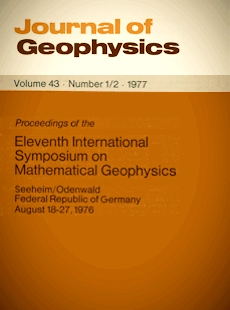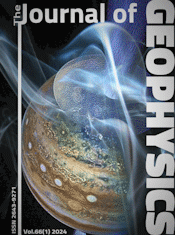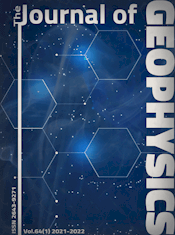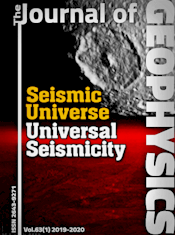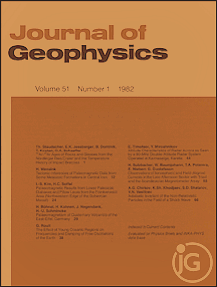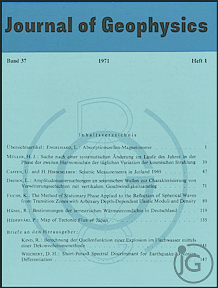Lithospheric slab penetration into the lower mantle beneath the Sea of Okhotsk
Article Sidebar
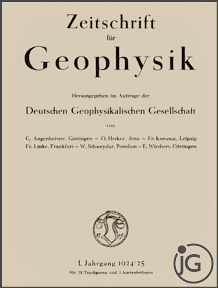
Vols. 1-18 (1924-1944), ISSN 0044-2801
Main Article Content
Abstract
A set of 142 S and ScS absolute travel times and 62 ScS-S differential travel times from short-period recordings of the January 29, 1971, Sea of Okhotsk deep-focus earthquake has been analyzed to obtain estimates of the source anomaly as a function of position on the residual sphere. In the processing algorithm the station anomalies and travel times are treated as gaussian random variables with known variance matrices. A system of normal equations is found by minimizing a quadratic form that is the sum of three terms: a measure of the misfit to the absolute travel times, a measure of the misfit to the differential travel times, and a measure of the misfit to the estimated station anomalies. An approximate solution to the system of normal equations is derived by requiring that the source anomaly be a smooth function of position on the residual sphere. This fitting procedure yields a saddle-shaped source anomaly pattern. The pattern is compatible with the presence of a planar high-velocity zone beneath the source with a nearly vertical dip and a strike parallel to the Kuril-Kamchatka Arc. Ray tracing calculations have been used to model the anomaly. A high-velocity slab extending to a depth of 1000 km along the extrapolation of the Benioff Zone, with a velocity contrast of 5%, is consistent with the data. The anomaly is interpreted to be the expression of lithospheric material that has penetrated the lower mantle. This study and data from other subduction zones suggest that lithospheric slab penetration below the 650 km discontinuity is a general feature of mantle structure in regions of rapid plate convergence. It is concluded that the lower mantle participates in the thermal convection responsible for plate motions.
 ARK: https://n2t.net/ark:/88439/y099157
ARK: https://n2t.net/ark:/88439/y099157
Permalink: https://geophysicsjournal.com/article/148
Article Details
References
Bullen, K.E. (1963) Introduction to the theory of seismology, 3rd ed. Cambridge University Press
Davies, D., McKenzie, D.P. (1969) Seismic travel-time residuals and plates. Geophys. J. R. Astr. Soc. 18:51-63
Davies, D., Sheppard, R.M. (1972) Lateral heterogeneity in the Earth's mantle. Nature 239:318-323
Davies, G.F. (1976) Whole mantle convection and plate tectonics. Submitted for publication
Douglas, R.J.W. (Ed.) (1970) Geology and economic minerals of Canada. Ottawa, Ont.: Dept. Energy, Mines and Resources, p. 3 and pp. 44-150
Engdahl, E.R. (1973) Relocation of intermediate depth earthquakes in the Central Aleutians by seismic ray tracing. Nature 245:23-25
Engdahl, E.R. (1975) Effects of plate structure and dilatancy on relative teleseismic P-wave residuals. Geophys. Res. Lett. 2:420-422
Griggs, D.T. (1972) The sinking of the lithosphere and the focal mechanism of deep earthquakes. In: Robertson, E.C. (Ed.) The nature of the solid Earth, pp. 361-384. McGraw-Hill, New York
Hashizume, M. (1976) Surface-wave study of the Canadian Shield. Phys. Earth Planet. Int. 11:333-351
International Seismological Centre (1971), Bulletin Edinburgh
Isacks, B., Molnar, P. (1969) Mantle earthquake mechanisms and the sinking of the lithosphere. Nature 223:1121-1124
Jackson, I.N.S., Liebermann, R.C., Ringwood, A.E. (1974) Disproportionation of spinels to mixed oxides: significance of cation configuration and implications for the mantle. Earth Planet. Sci. Lett. 24:203-208
Jeffreys, H., Bullen, K.E. (1940) Seismological Tables. British Association for the Advancement of Science, Gray-Milne Trust
Jordan, T.H. (1975) Lateral heterogeneity and mantle dynamics. Nature 257:745-750
Jordan, T.H., Minster, J.B. (1972) Application of a stochastic inverse to the geophysical inverse problem. In: Colin, L. (Ed.) Mathematics of profile inversion, pp. 7-36-7-47, NASA Technical Memorandum X-62150
Jordan, T.H., Lynn, W.S. (1974) A velocity anomaly in the lower mantle. J. Geophys. Res. 79:2679-2685
Long, R.E., Mitchell, M.G. (1970) Teleseismic P-wave delay time in Iceland. Geophys. J. R. Astr. Soc. 20:41-48
McKenzie, D.P. (1969) Speculations on the causes and consequences of plate motions. Geophys. J. R. Astr. Soc. 18:1-32
McKenzie, D.P., Roberts, J.M., Weiss, N.O. (1974) Convection in the earth's mantle: towards a numerical simulation. J. Fluid Mech. 62:465-538
Mitronovas, W., Isacks, B.L. (1971) Seismic velocity anomalies in the upper mantle beneath the TongaKermadec Island Arc. J. Geophys. Res. 76:7154-7180
National Oceans and Atmospheric Administration, U.S. Dept. Interior (1971) Preliminary determination of epicenters, Denver, Colorado
O'Connell, R.J. (1976) On the scale of mantle convection. Tectonophysics (In press)
Powell, C.A. (1976) Mantle heterogeneity: evidence from large seismic arrays. Ph.D. Thesis, Princeton Univ.
Richter, R.M., Parsons, B. (1975) On the interaction of two scales of convection. J. Geophys. Res. 80:2529-2541
Schubert, G., Yuen, D.A., Turcotte, D.L. (1975) Role of phase transitions in a dynamic mantle. Geophys. J. R. Astr. Soc. 42:705-735
Sengupta, M.K. (1975) The structure of the earth's mantle from body wave observations. Ph.D. Thesis, Mass. Inst. of Tech.
Sipkin, S.A., Jordan, T.H. (1975) Lateral heterogeneity of the upper mantle determined from the travel times of ScS. J. Geophys. Res. 80:1474-1484
Sipkin, S.A., Jordan, T.H. (1976) Lateral heterogeneity of the upper mantle determined from the travel times of multiple ScS. J. Geophys. Res. 81:6307-6320
Sleep, N.H. (1973) Teleseismic P-wave transmission through slabs. Bull. Seis. Soc. Am. 63:1349-1373
Toksoz, M.N., Minear, J.W., Julian, B.R. (1971) Temperature field and geophysical effects of a downgoing slab. J. Geophys. Res. 76:1113-1138
Veith, K.F. (1974) The relationship of island arc seismicity to plate tectonics. Ph.D. Thesis, S. Methodist Univ.
Weichert, D.H. (1972) Anomalous azimuths of P: evidence for lateral variations in the deep mantle. Earth Planet. Sci. Lett. 17:181-188


